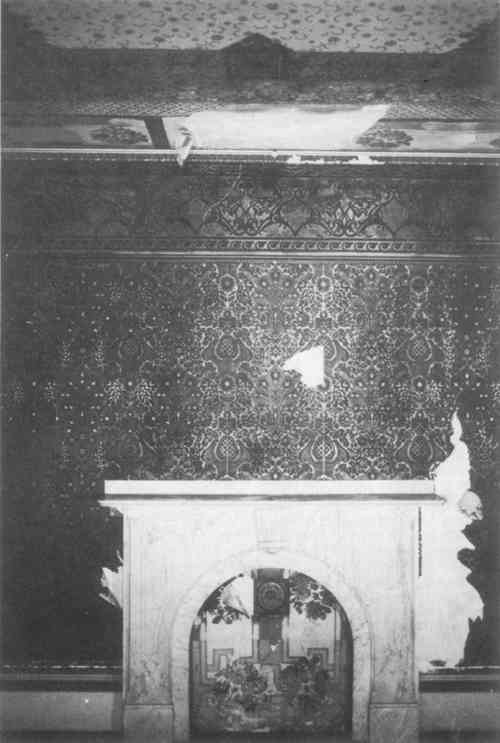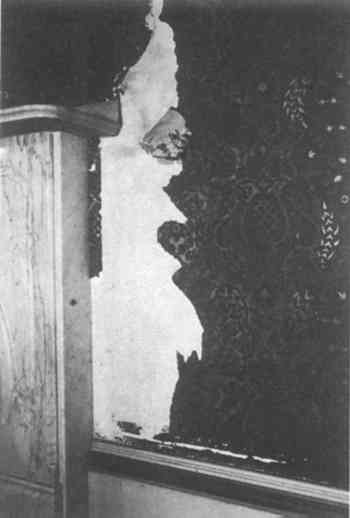WALLPAPER AND ITS CONSERVATION—AN ARCHITECTURAL CONSERVATOR'S PERSPECTIVEAndrea M. Gilmore
2 CONSERVATION OF LARGE AREAS OF HISTORIC WALLPAPERWhen entire rooms of historic wallpaper or large portions of a room's wallpaper remain, conservation, rather than reproduction of the historic wallpaper, is the preferred restoration objective. This preference for wallpaper conservation has only The conservation of entire rooms or large areas of wallpaper requires the collaboration of the architectural conservator, the wallpaper conservator, and the historic building curator. Figures 1–3 illustrate some of the problems encountered when conservation of an entire room of wallpaper is undertaken. Working together, they must determine the appropriate conservation treatment for a particular wallpaper based on the following criteria:
The artistic and historical significance of the early wallpapers found in historic buildings vary considerably. These variations should be reflected in the comprehensiveness of the conservation treatments which they receive. Two wallpapers located in National Park Service buildings illustrate this point well. The Zuber scenic “Paysage � Chasse” at Lindenwald, the Martin Van Buren National Historic Site in Kinderhook, NY, is both an artistically and a historically significant wallpaper. Its artistic significance is derived from the fact that it is a rag paper with a complex, block-printed scenic design. It is historically significant because it hung in the primary receiving hall at Lindenwald when it was the residence of the former U.S. President Martin Van Buren, the period to which the house is being restored. It is also one of a limited number of furnishings that can be positively dated to his residency at Lindenwald. This wallpaper is currently receiving extensive conservation treatments described in the presentation by James and Patricia Dacus Hamm. The other paper is located in the southwest parlor of the Narbonne House at the Salem Maritime National Historic Site in Salem, MA. This house is to be preserved as it was when it was acquired by the National Park Service in 1964; therefore, all the wallpapers in the house are to be preserved. This wallpaper is a mechanical wood-pulp paper, machine printed with a colonial revival design. It dates from c. 1930. This paper will receive only basic conservation treatments. It will be treated in situ—its surfaces dry cleaned and readhered to the plaster walls. Determination of the artistic and historic significance of a historic wallpaper is primarily the task of the building's curator.
Establishing the scope of the conservation treatment for a particular wallpaper falls mostly within the domain of the paper and paintings conservator; however, with regard to the decision of whether to treat a paper in situ or remove it from the walls for treatment, the architectural conservator has a definite bias. Since the architectural conservator considers wallpaper to be an integral part of the interior Determining the physical and environmental factors that most directly affect the stability of a historic wallpaper requires that the room in which the paper hangs be carefully monitored. This monitoring should include: structural movement in the plaster walls, the moisture content of the plaster walls, and the temperature, relative humidity, and levels of illumination, with the identification of the proportion of UV, in the room. Ideally, monitoring should be done for a full year so that the complete range of climate-related variations can be recorded. Evaluation of the monitoring data should be done by the architectural and wallpaper conservators. Based on the data, the architectural conservator should make any physical alterations required. For example, plaster walls can be stabilized by replacing rotten wooden sills or by plaster consolidation. The moisture content in an exterior wall can be reduced by repairing leaking roofs, gutters and downspouts and by repointing the exterior brick walls. UV filters can be put on the windows. Evaluating how a proposed wallpaper conservation treatment will affect the other architectural elements in a room is primarily the responsibility of the architectural conservator. The two principal criteria used by the architectural conservator to make this determination are:
An example of an unacceptable treatment would be to rehang a conserved wallpaper by mounting it on a �″ thick frame, applied to the walls with a high strength bonding adhesive. The thickness of the frame would destroy the relationship of the wallpaper to the other architectural elements in the room—specifically any door and window frames, baseboards or cornice moldings. In addition, the bonding strength of the adhesive would remove a layer of the plaster substrate if the conserved wallpaper had to be removed at a later date. A final consideration must always be the monies available for conservation treatments. The funds available may determine the comprehensiveness of a treatment proposal. Insufficient funds may require that less complete treatments be carried out or that treatments be postponed. Postponement of conservation treatments raises the difficult question of what to do with a room of wallpaper in the interim. For example, how does an architectural conservator or a historic house curator prevent further damage to a torn wallpaper that is pulling away from the plaster walls? |


